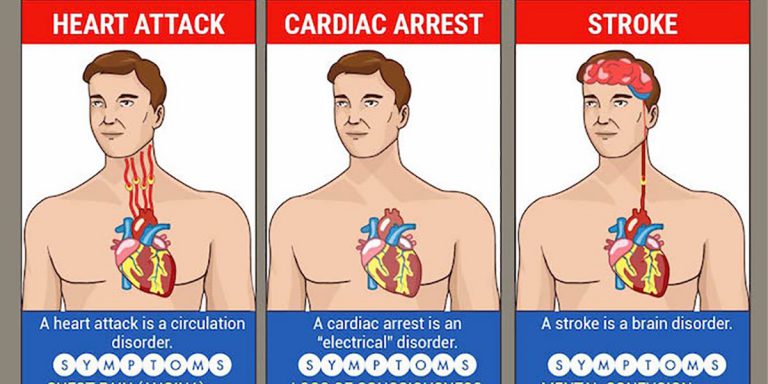Cardiovascular diseases are currently the chief cause of premature death in the world. Because of this, it is extremely important to understand how the two cardiovascular diseases, namely heart attack, and heart stroke can affect the body.
Both heart attack and stroke are life-threatening cardiovascular diseases that require immediate medical attention. While they may share similar risks and effects, both are different medical conditions.
Heart attack and stroke both involve blood vessels (mainly arteries) but affect different organs in the body and their symptoms may also vary.
Similar Risk Factors for Heart Attack and Stroke
Despite being different, heart attack and stroke have the same risk factors. These include diabetes, smoking, high cholesterol, a sedentary lifestyle, heredity or family history, high blood pressure, excessive consumption of alcohol, obesity, and many more.
Heart Attack and Stroke – The Difference
The inner wall of one of the chief arteries gets blocked because of plaque at the time of a heart attack. This restricts the blood flow to the heart and damages the heart muscle. On the other hand, a stroke involves a blood clot (ischemic) or a ruptured vessel (haemorrhage) in the brain. It is not based in the heart.
It is important to know that every minute is precious for the victims of both stroke and heart attack. The sooner you know whether it is a heart attack or a stroke, the better are the chances of survival and complete recovery. However, it is essential to understand the symptoms and signs of both these cardiovascular diseases in order to ensure immediate treatment.
Heart Attack
The heart is one of the most complex and vital organs of the human body. The consequences of our modern lifestyles can prove to be catastrophic for the organ. A heart attack occurs when the flow of blood to the coronary artery is either blocked or decreased. As a result, the blood flow to the heart is stopped. This occurs because of the build-up of plaque (cholesterol and fatty substance) in the walls of the coronary arteries that provide blood to the heart muscle.
Plaque typically builds up over many years and does not develop overnight. If a piece of the plaque build-up gets detached from a heart artery, it may create a blood clot around it. This can in turn stop or obstruct the normal blood flow to your heart muscle. As a result, a part of the heart muscle may not get sufficient oxygen. This part of the heart starts getting damaged and may even die if the blockage is not immediately treated.
When the part of the heart muscle starts to die or is damaged because of a lack of appropriate blood flow (which provides nutrients and oxygen to the heart), a heart attack may occur.
Stroke
A stroke, also known as a ‘brain attack’, occurs when a blood vessel carrying oxygen and other necessary nutrients to the brain bursts or is blocked by a clot. Brain cells start to die if they don’t get oxygen. This can result in a stroke.
Treatment for this disease is the most effective when administered within the first few hours after it has occurred. Thus, it is crucial to be able to distinguish the symptoms and act fast.
Recognizing the Symptoms of Heart Attacks & Strokes
Both stroke and heart attacks may have similar symptoms, but there are still some significant differences. In both situations, medical treatment is required quickly.
Symptoms of a Heart Attack
Not all heart attacks are the same. Chest pain may not be involved every time. There may be discomfort or uneasiness or a feeling of pressure on the chest. Listed below are some common symptoms of a heart attack:
- Pain/discomfort in chest, shoulder, arm, elbow, and jaw
- Sweating
- Dizziness and nausea
- Shortness of breath
The symptoms may vary from person to person. Some may have very mild to no symptoms and may suffer a ‘silent heart attack’.
Symptoms of a Stroke
Symptoms of a stroke depend on the location or part of the brain that is damaged. Brain damage can have a negative impact on many functions like muscle control, memory, and speech. Some common symptoms are:
- Facial droopiness
- Sudden numbness or weakness in the arm, leg, face, or generally on one side of the body
- Severe unexpected headaches, together with vomiting, distorted consciousness, or giddiness
- Difficulty or confusion in speaking, or slurred speech
- Dizziness, difficulty in walking, or sudden loss of balance
- Partial vision loss or trouble seeing from one eye or both eyes
Treatment
Treating a Heart Attack
A heart attack patient brought to the hospital would be given clot-busting medications. Procedures such as angioplasty (surgical unblocking or repair of a coronary artery) or stent placement would be needed in some cases. Some patients in a serious condition may also need an emergency Coronary Artery Bypass (redirecting blood around a section of a completely or partially blocked artery in the heart to improve blood flow).
Treating a Stroke
The initial step in treating a stroke is to identify its type through a CT scan. If the scan shows that the stroke is ischemic (caused by a blood clot which caps or blocks a blood vessel in the brain) and the patient has been brought to the hospital within 4.5 hours of the onset of symptoms, then thrombolysis (dissolution of a blood clot particularly induced artificially) can be administered.
Both heart attack and stroke can lead to life-threatening consequences for the body, but stroke survivors have an increased chance of facing serious disabilities.
Bottom line, we can make certain lifestyle changes and avail some health screenings like Whole Body Health Check or Healthy Heart Package on a regular basis to ensure that the risk of suffering from these conditions is reduced.


